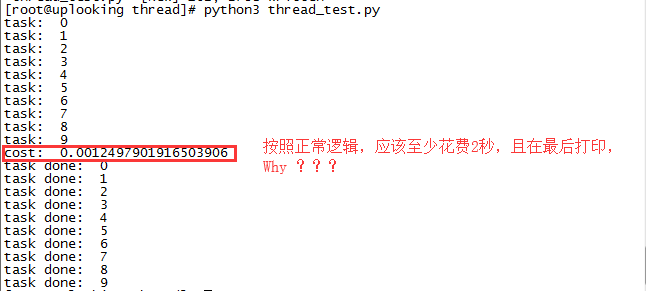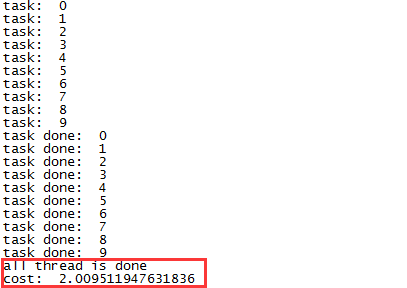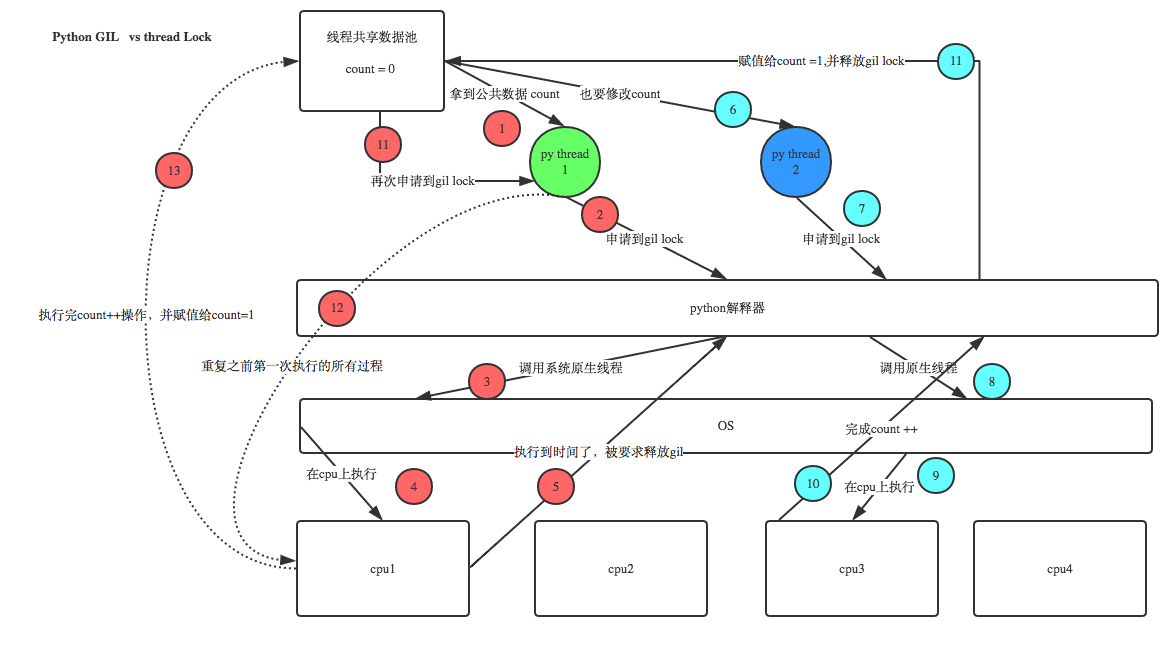Python 并发编程之进程、线程
概述
我们都知道windows是支持多任务的操作系统。
什么叫“多任务”呢?简单地说,就是操作系统可以同时运行多个任务。打个比方,你一边在用浏览器上网,一边在听MP3,一边在用Word赶作业,这就是多任务,至少同时有3个任务正在运行。还有很多任务悄悄地在后台同时运行着,只是桌面上没有显示而已。
现在,多核CPU已经非常普及了,但是,即使过去的单核CPU,也可以执行多任务。由于CPU执行代码都是顺序执行的,那么,单核CPU是怎么执行多任务的呢?
答案就是操作系统轮流让各个任务交替执行,任务1执行0.01秒,切换到任务2,任务2执行0.01秒,再切换到任务3,执行0.01秒……这样反复执行下去。表面上看,每个任务都是交替执行的,但是,由于CPU的执行速度实在是太快了,我们感觉就像所有任务都在同时执行一样。
真正的并行执行多任务只能在多核CPU上实现,但是,由于任务数量远远多于CPU的核心数量,所以,操作系统也会自动把很多任务轮流调度到每个核心上执行。
对于操作系统来说,一个任务就是一个进程(Process),比如打开一个浏览器就是启动一个浏览器进程,打开一个记事本就启动了一个记事本进程,打开两个记事本就启动了两个记事本进程,打开一个Word就启动了一个Word进程。
有些进程还不止同时干一件事,比如Word,它可以同时进行打字、拼写检查、打印等事情。在一个进程内部,要同时干多件事,就需要同时运行多个“子任务”,我们把进程内的这些“子任务”称为线程(Thread)。
由于每个进程至少要干一件事,所以,一个进程至少有一个线程。当然,像Word这种复杂的进程可以有多个线程,多个线程可以同时执行,多线程的执行方式和多进程是一样的,也是由操作系统在多个线程之间快速切换,让每个线程都短暂地交替运行,看起来就像同时执行一样。当然,真正地同时执行多线程需要多核CPU才可能实现。
我们前面编写的所有的Python程序,都是执行单任务的进程,也就是只有一个线程。如果我们要同时执行多个任务怎么办?有两种解决方案:
- 一种是启动多个进程,每个进程虽然只有一个线程,但多个进程可以一块执行多个任务。
- 一种方法是启动一个进程,在一个进程内启动多个线程,这样,多个线程也可以一块执行多个任务。
启动多个进程,每个进程再启动多个线程,这样同时执行的任务就更多了,当然这种模型更复杂,实际很少采用。
总结一下就是,多任务的实现有3种方式:
- 多进程模式
- 多线程模式
- 多进程 + 多线程模式
同时执行多个任务通常各个任务之间并不是没有关联的,而是需要相互通信和协调,有时,任务1必须暂停等待任务2完成后才能继续执行,有时,任务3和任务4又不能同时执行,所以,多进程和多线程的程序的复杂度要远远高于我们前面写的单进程单线程的程序。
进程与线程
什么是进程(process)?
程序并不能单独运行,只有将程序装载到内存中,系统为它分配资源才能运行,而这种执行的程序就称之为进程。程序和进程的区别就在于:程序是指令的集合,它是进程运行的静态描述文本;进程是程序的一次执行活动,属于动态概念。
在多道编程中,我们允许多个程序同时加载到内存中,在操作系统的调度下,可以实现并发地执行。这是这样的设计,大大提高了CPU的利用率。进程的出现让每个用户感觉到自己独享CPU,因此,进程就是为了在CPU上实现多道编程而提出的。
有了进程为什么还要线程?
进程有很多优点,它提供了多道编程,让我们感觉我们每个人都拥有自己的CPU和其他资源,可以提高计算机的利用率。很多人就不理解了,既然进程这么优秀,为什么还要线程呢?其实,仔细观察就会发现进程还是有很多缺陷的,主要体现在两点上:
-
进程只能在一个时间干一件事,如果想同时干两件事或多件事,进程就无能为力了。
-
进程在执行的过程中如果阻塞,例如等待输入,整个进程就会挂起,即使进程中有些工作不依赖于输入的数据,也将无法执行。
例如,我们在使用qq聊天, qq做为一个独立进程如果同一时间只能干一件事,那他如何实现在同一时刻 即能监听键盘输入、又能监听其它人给你发的消息、同时还能把别人发的消息显示在屏幕上呢?你会说,操作系统不是有分时么?但我的亲,分时是指在不同进程间的分时呀, 即操作系统处理一会你的qq任务,又切换到word文档任务上了,每个cpu时间片分给你的qq程序时,你的qq还是只能同时干一件事呀。
再直白一点, 一个操作系统就像是一个工厂,工厂里面有很多个生产车间,不同的车间生产不同的产品,每个车间就相当于一个进程,且你的工厂又穷,供电不足,同一时间只能给一个车间供电,为了能让所有车间都能同时生产,你的工厂的电工只能给不同的车间分时供电,但是轮到你的qq车间时,发现只有一个干活的工人,结果生产效率极低,为了解决这个问题,应该怎么办呢?。。。。没错,你肯定想到了,就是多加几个工人,让几个人工人并行工作,这每个工人,就是线程!
什么是线程(thread)?
线程是操作系统能够进行运算调度的最小单位。它被包含在进程之中,是进程中的实际运作单位。一条线程指的是进程中一个单一顺序的控制流,一个进程中可以并发多个线程,每条线程并行执行不同的任务
进程和线程的区别
Python GIL(Global Interpreter Lock)
Threading模块
import threading import time def sayhi(num): # 定义每个线程要运行的函数 print("running on number:%s" % num) time.sleep(3) if __name__ == '__main__': t1 = threading.Thread(target=sayhi, args=(1,)) # 生成一个线程实例 t2 = threading.Thread(target=sayhi, args=(2,)) # 生成另一个线程实例 t1.start() # 启动线程 t2.start() # 启动另一个线程 print(t1.getName()) # 获取线程名 print(t2.getName())
方式二、继承式调用
import threading import time class MyThread(threading.Thread): def __init__(self, num): threading.Thread.__init__(self) self.num = num def run(self): # 定义每个线程要运行的函数 print("running on number:%s" % self.num) time.sleep(3) if __name__ == '__main__': t1 = MyThread(1) t2 = MyThread(2) t1.start() t2.start() print(t1.getName()) # 获取线程名 print(t2.getName())
线程相关的其他方法
Thread实例对象的方法 # isAlive(): 返回线程是否活动的。 # getName(): 返回线程名。 # setName(): 设置线程名。 threading模块提供的一些方法 # threading.currentThread(): 返回当前的线程变量。 # threading.enumerate(): 返回一个包含正在运行的线程的list。正在运行指线程启动后、结束前,不包括启动前和终止后的线程。 # threading.activeCount(): 返回正在运行的线程数量,与len(threading.enumerate())有相同的结果。

import threading def work(): import time time.sleep(3) print('子线程',threading.current_thread().getName()) if __name__ == '__main__': #在主进程下开启线程 t=threading.Thread(target=work) t.start() print('主线程',threading.current_thread().getName()) print(threading.current_thread()) #主线程 print(threading.enumerate()) #连同主线程在内有两个运行的线程 print(threading.active_count()) print('主线程/主进程') #运行结果: 主线程 MainThread <_MainThread(MainThread, started 139847151589184)> [<_MainThread(MainThread, started 139847151589184)>, <Thread(Thread-1, started 139847026968320)>] 2 主线程/主进程 子线程 Thread-1
线程的join方法
下面是一个对多线程的一个处理方法:(需要理解):
import threading import time def run(n): print("task: ",n) time.sleep(2) print("task done: ",n) start_time = time.time() for i in range(10): t = threading.Thread(target=run,args=(i,)) t.start() print("cost: ",time.time() - start_time)
运行结果如下所示:

是因为这个程序本身就是一个主线程,主线程又起了子线程,这时子线程和主线程已经没关系了,相当于子线程和主线程是并行的。这就解释了为什么我的主线程启动了子线程之后,没有等子线程执行完毕,主线程就继续往下走了。
但是现在有个问题,我们需要计算所有线程的执行时间,并且让所有线程运行之后再运行主程序
这里就需要用到线程里的一个方法join(),意思其实就是等待的意思。代码如下:
import threading import time def run(n): print("task: ",n) time.sleep(2) print("task done: ",n) start_time = time.time() t_obj = [] #存线程实例 for i in range(10): t = threading.Thread(target=run,args=(i,)) t.start() t_obj.append(t) #为了不阻塞后面线程的启动,不在这里join,先放到一个列表里 for i in t_obj: #循环线程实例列表,等待所有线程执行完毕 i.join() print("all thread is done") print("cost: ",time.time() - start_time)
运行结果:

以下是对join的理解:
没有加join的时候,主线程不会等子线程执行完毕再往下走,主线程和子线程的执行完全是并行的,没有依赖关系,你执行,我也执行。但是,你会发现,最终退出的时候,主线程依然会等待所有的子线程执行完毕才退出程序。虽然不等你执行完毕才往下走,但是在程序退出之前,会默认还有一个join
但加了join的时候,主线程依赖子线程执行完毕之后, 再往下走,这是JOIN 的作用。
守护线程
如果将线程设置为守护线程,则主程序不会管线程是否执行完,只有主程序执行完毕之后,就会结束
代码例子如下:
import threading import time def run(n): print("task: ",n) time.sleep(2) print("task done: ",n) start_time = time.time() for i in range(10): t = threading.Thread(target=run,args=(i,)) t.setDaemon(True) #把当前线程设置为守护线程,必须在t.start()之前设置 t.start() print("all thread is done",threading.current_thread(),threading.active_count()) print("cost: ",time.time() - start_time)
运行结果:

线程锁(互斥锁Mutex)
import time import threading def minus_num(): global num #在每个线程中都获取这个全局变量 print('--get num:',num ) time.sleep(1) num -=1 #对此公共变量进行-1操作 num = 100 #设定一个共享变量 thread_list = [] for i in range(100): t = threading.Thread(target=minus_num,) t.start() thread_list.append(t) for t in thread_list: #等待所有线程执行完毕 t.join() print('final num:', num )
正常来讲,这个num结果应该是0, 但在python 2.7上多运行几次,会发现,最后打印出来的num结果不总是0,为什么每次运行的结果不一样呢? 哈,很简单,假设你有A,B两个线程,此时都 要对num 进行减1操作, 由于2个线程是并发同时运行的,所以2个线程很有可能同时拿走了num=100这个初始变量交给cpu去运算,当A线程去处完的结果是99,但此时B线程运算完的结果也是99,两个线程同时CPU运算的结果再赋值给num变量后,结果就都是99。那怎么办呢? 很简单,每个线程在要修改公共数据时,为了避免自己在还没改完的时候别人也来修改此数据,可以给这个数据加一把锁, 这样其它线程想修改此数据时就必须等待你修改完毕并把锁释放掉后才能再访问此数据。
但是经过测试在3.0上不存在这个问题,可能是自动加了锁。
加锁版本
import time import threading def minus_num(): global num #在每个线程中都获取这个全局变量 print('--get num:',num ) time.sleep(1) lock.acquire() #修改数据前加锁 num -=1 #对此公共变量进行-1操作 lock.release() #修改后释放 num = 100 #设定一个共享变量 thread_list = [] lock = threading.Lock() #生成全局锁 for i in range(100): t = threading.Thread(target=minus_num,) t.start() thread_list.append(t) for t in thread_list: #等待所有线程执行完毕 t.join() print('final num:', num )
GIL VS Lock
既然Python已经有一个GIL来保证同一时间只能有一个线程来执行了,为什么这里还需要lock? 注意啦,这里的lock是用户级的lock,跟那个GIL没关系 ,看下图


分析: #1.100个线程去抢GIL锁,即抢执行权限 #2. 肯定有一个线程先抢到GIL(暂且称为线程1),然后开始执行,一旦执行就会拿到lock.acquire() #3. 极有可能线程1还未运行完毕,就有另外一个线程2抢到GIL,然后开始运行,但线程2发现互斥锁lock还未被线程1释放,于是阻塞,被迫交出执行权限,即释放GIL #4.直到线程1重新抢到GIL,开始从上次暂停的位置继续执行,直到正常释放互斥锁lock,然后其他的线程再重复2 3 4的过程

#不加锁:并发执行,速度快,数据不安全 from threading import current_thread,Thread,Lock import os,time def task(): global n print('%s is running' %current_thread().getName()) temp=n time.sleep(0.5) n=temp-1 if __name__ == '__main__': n=100 lock=Lock() threads=[] start_time=time.time() for i in range(100): t=Thread(target=task) threads.append(t) t.start() for t in threads: t.join() stop_time=time.time() print('主:%s n:%s' %(stop_time-start_time,n)) ''' Thread-1 is running Thread-2 is running ...... Thread-100 is running 主:0.5216062068939209 n:99 ''' #不加锁:未加锁部分并发执行,加锁部分串行执行,速度慢,数据安全 from threading import current_thread,Thread,Lock import os,time def task(): #未加锁的代码并发运行 time.sleep(3) print('%s start to run' %current_thread().getName()) global n #加锁的代码串行运行 lock.acquire() temp=n time.sleep(0.5) n=temp-1 lock.release() if __name__ == '__main__': n=100 lock=Lock() threads=[] start_time=time.time() for i in range(100): t=Thread(target=task) threads.append(t) t.start() for t in threads: t.join() stop_time=time.time() print('主:%s n:%s' %(stop_time-start_time,n)) ''' Thread-1 is running Thread-2 is running ...... Thread-100 is running 主:53.294203758239746 n:0 ''' #这里有个问题:既然加锁会让运行变成串行,那么我在start之后立即使用join,就不用加锁了啊,也是串行的效果啊 #没错:在start之后立刻使用jion,肯定会将100个任务的执行变成串行,毫无疑问,最终n的结果也肯定是0,是安全的,但问题是 #start后立即join:任务内的所有代码都是串行执行的,而加锁,只是加锁的部分即修改共享数据的部分是串行的 #单从保证数据安全方面,二者都可以实现,但很明显是加锁的效率更高. from threading import current_thread,Thread,Lock import os,time def task(): time.sleep(3) print('%s start to run' %current_thread().getName()) global n temp=n time.sleep(0.5) n=temp-1 if __name__ == '__main__': n=100 lock=Lock() start_time=time.time() for i in range(100): t=Thread(target=task) t.start() t.join() stop_time=time.time() print('主:%s n:%s' %(stop_time-start_time,n)) ''' Thread-1 start to run Thread-2 start to run ...... Thread-100 start to run 主:350.6937336921692 n:0 #耗时是多么的恐怖 '''
RLock(递归锁)
说白了就是在一个大锁中还要再包含子锁
import threading,time def run1(): print("grab the first part data") lock.acquire() global num num +=1 lock.release() return num def run2(): print("grab the second part data") lock.acquire() global num2 num2+=1 lock.release() return num2 def run3(): lock.acquire() res = run1() print('--------between run1 and run2-----') res2 = run2() lock.release() print(res,res2) if __name__ == '__main__': num,num2 = 0,0 lock = threading.RLock() for i in range(10): t = threading.Thread(target=run3) t.start() while threading.active_count() != 1: print(threading.active_count()) else: print('----all threads done---') print(num,num2)
Semaphore(信号量)
互斥锁同时只允许一个线程更改数据,而信号量可以同时允许一定数量的线程更改数据。
import threading,time def run(n): semaphore.acquire() time.sleep(1) print("run the thread: %s\n" %n) semaphore.release() if __name__ == '__main__': num= 0 semaphore = threading.BoundedSemaphore(5) #最多允许5个线程同时运行 for i in range(20): t = threading.Thread(target=run,args=(i,)) t.start() while threading.active_count() != 1: pass else: print('----all threads done---') print(num)
与进程池是完全不同的概念,进程池Pool(4),最大只能产生4个进程,而且从头到尾都只是这四个进程,不会产生新的,而信号量是产生一堆线程/进程
Events(事件)
线程的一个关键特性是每个线程都是独立运行且状态不可预测。如果程序中的其 他线程需要通过判断某个线程的状态来确定自己下一步的操作,这时线程同步问题就会变得非常棘手。为了解决这些问题,我们需要使用threading库中的Event对象。 对象包含一个可由线程设置的信号标志,它允许线程等待某些事件的发生。在 初始情况下,Event对象中的信号标志被设置为假。如果有线程等待一个Event对象, 而这个Event对象的标志为假,那么这个线程将会被一直阻塞直至该标志为真。一个线程如果将一个Event对象的信号标志设置为真,它将唤醒所有等待这个Event对象的线程。如果一个线程等待一个已经被设置为真的Event对象,那么它将忽略这个事件, 继续执行。
Python threading模块提供Event对象用于线程间通信。它提供了一组、拆除、等待用于线程间通信的其他方法。
事件处理的机制:全局定义了一个内置标志Flag,如果Flag值为 False,那么当程序执行 event.wait方法时就会阻塞,如果Flag值为True,那么event.wait 方法时便不再阻塞。
Event其实就是一个简化版的 Condition。Event没有锁,无法使线程进入同步阻塞状态。
Event()
- set(): 将标志设为True,并通知所有处于等待阻塞状态的线程恢复运行状态。
- clear(): 将标志设为False。
- wait(timeout): 如果标志为True将立即返回,否则阻塞线程至等待阻塞状态,等待其他线程调用set()。
- isSet(): 获取内置标志状态,返回True或False。
通过Event来实现两个或多个线程间的交互,下面是一个红绿灯的例子,即起动一个线程做交通指挥灯,生成几个线程做车辆,车辆行驶按红灯停,绿灯行的规则。
import threading import time import random def light(): if not event.isSet(): event.set() #event.wait()就不阻塞,表示绿灯状态 count = 0 while True: if count < 5: print('\033[42;1m--green light on---\033[0m') elif count < 8: print('\033[43;1m--yellow light on---\033[0m') elif count < 13: if event.isSet(): event.clear() #清除标志位,event.isSet()返回False,表示红灯状态 print('\033[41;1m--red light on---\033[0m') else: count = 0 event.set() #设置标志位,event.isSet()返回True,表示绿灯状态 continue time.sleep(1) count += 1 def car(n): while True: time.sleep(random.randrange(10)) if event.isSet(): #判断标志状态,如果返回True,则绿灯行 print("car [%s] is running.." % n) else: #红灯停 print("car [%s] is waiting for the red light.." % n) if __name__ == '__main__': event = threading.Event() Light = threading.Thread(target = light,) Light.start() for i in range(3): t = threading.Thread(target = car,args = (i,)) t.start()
条件Condition(了解)
import threading def run(n): con.acquire() con.wait() print("run the thread: %s" %n) con.release() if __name__ == '__main__': con = threading.Condition() for i in range(10): t = threading.Thread(target=run, args=(i,)) t.start() while True: inp = input('>>>') if inp == 'q': break con.acquire() con.notify(int(inp)) con.release()

def condition_func(): ret = False inp = input('>>>') if inp == '1': ret = True return ret def run(n): con.acquire() con.wait_for(condition_func) print("run the thread: %s" %n) con.release() if __name__ == '__main__': con = threading.Condition() for i in range(10): t = threading.Thread(target=run, args=(i,)) t.start()
定时器
定时器,指定n秒后执行某操作
from threading import Timer def hello(): print("hello, world") t = Timer(1, hello) t.start() # after 1 seconds, "hello, world" will be printed

from threading import Timer import random,time class Code: def __init__(self): self.make_cache() def make_cache(self,interval=5): self.cache=self.make_code() print(self.cache) self.t=Timer(interval,self.make_cache) self.t.start() def make_code(self,n=4): res='' for i in range(n): s1=str(random.randint(0,9)) s2=chr(random.randint(65,90)) res+=random.choice([s1,s2]) return res def check(self): while True: inp=input('>>: ').strip() if inp.upper() == self.cache: print('验证成功',end='\n') self.t.cancel() break if __name__ == '__main__': obj=Code() obj.check()
线程queue
queue队列 :使用import queue,用法与进程Queue一样
queue is especially useful in threaded programming when information must be exchanged safely between multiple threads.
class queue.Queue(maxsize=0) #先进先出

import queue q=queue.Queue() q.put('first') q.put('second') q.put('third') print(q.get()) print(q.get()) print(q.get()) ''' 结果(先进先出): first second third '''
class queue.LifoQueue(maxsize=0) #last in fisrt out

import queue q=queue.LifoQueue() q.put('first') q.put('second') q.put('third') print(q.get()) print(q.get()) print(q.get()) ''' 结果(后进先出): third second first '''
class queue.PriorityQueue(maxsize=0) #存储数据时可设置优先级的队列

import queue q=queue.PriorityQueue() #put进入一个元组,元组的第一个元素是优先级(通常是数字,也可以是非数字之间的比较),数字越小优先级越高 q.put((20,'a')) q.put((10,'b')) q.put((30,'c')) print(q.get()) print(q.get()) print(q.get()) ''' 结果(数字越小优先级越高,优先级高的优先出队): (10, 'b') (20, 'a') (30, 'c') '''
其他

Constructor for a priority queue. maxsize is an integer that sets the upperbound limit on the number of items that can be placed in the queue. Insertion will block once this size has been reached, until queue items are consumed. If maxsize is less than or equal to zero, the queue size is infinite. The lowest valued entries are retrieved first (the lowest valued entry is the one returned by sorted(list(entries))[0]). A typical pattern for entries is a tuple in the form: (priority_number, data). exception queue.Empty Exception raised when non-blocking get() (or get_nowait()) is called on a Queue object which is empty. exception queue.Full Exception raised when non-blocking put() (or put_nowait()) is called on a Queue object which is full. Queue.qsize() Queue.empty() #return True if empty Queue.full() # return True if full Queue.put(item, block=True, timeout=None) Put item into the queue. If optional args block is true and timeout is None (the default), block if necessary until a free slot is available. If timeout is a positive number, it blocks at most timeout seconds and raises the Full exception if no free slot was available within that time. Otherwise (block is false), put an item on the queue if a free slot is immediately available, else raise the Full exception (timeout is ignored in that case). Queue.put_nowait(item) Equivalent to put(item, False). Queue.get(block=True, timeout=None) Remove and return an item from the queue. If optional args block is true and timeout is None (the default), block if necessary until an item is available. If timeout is a positive number, it blocks at most timeout seconds and raises the Empty exception if no item was available within that time. Otherwise (block is false), return an item if one is immediately available, else raise the Empty exception (timeout is ignored in that case). Queue.get_nowait() Equivalent to get(False). Two methods are offered to support tracking whether enqueued tasks have been fully processed by daemon consumer threads. Queue.task_done() Indicate that a formerly enqueued task is complete. Used by queue consumer threads. For each get() used to fetch a task, a subsequent call to task_done() tells the queue that the processing on the task is complete. If a join() is currently blocking, it will resume when all items have been processed (meaning that a task_done() call was received for every item that had been put() into the queue). Raises a ValueError if called more times than there were items placed in the queue. Queue.join() block直到queue被消费完毕
Python标准模块--concurrent.futures
#1 介绍 concurrent.futures模块提供了高度封装的异步调用接口 ThreadPoolExecutor:线程池,提供异步调用 ProcessPoolExecutor: 进程池,提供异步调用 Both implement the same interface, which is defined by the abstract Executor class. #2 基本方法 #submit(fn, *args, **kwargs) 异步提交任务 #map(func, *iterables, timeout=None, chunksize=1) 取代for循环submit的操作 #shutdown(wait=True) 相当于进程池的pool.close()+pool.join()操作 wait=True,等待池内所有任务执行完毕回收完资源后才继续 wait=False,立即返回,并不会等待池内的任务执行完毕 但不管wait参数为何值,整个程序都会等到所有任务执行完毕 submit和map必须在shutdown之前 #result(timeout=None) 取得结果 #add_done_callback(fn) 回调函数

#介绍 The ProcessPoolExecutor class is an Executor subclass that uses a pool of processes to execute calls asynchronously. ProcessPoolExecutor uses the multiprocessing module, which allows it to side-step the Global Interpreter Lock but also means that only picklable objects can be executed and returned. class concurrent.futures.ProcessPoolExecutor(max_workers=None, mp_context=None) An Executor subclass that executes calls asynchronously using a pool of at most max_workers processes. If max_workers is None or not given, it will default to the number of processors on the machine. If max_workers is lower or equal to 0, then a ValueError will be raised. #用法 from concurrent.futures import ThreadPoolExecutor,ProcessPoolExecutor import os,time,random def task(n): print('%s is runing' %os.getpid()) time.sleep(random.randint(1,3)) return n**2 if __name__ == '__main__': executor=ProcessPoolExecutor(max_workers=3) futures=[] for i in range(11): future=executor.submit(task,i) futures.append(future) executor.shutdown(True) print('+++>') for future in futures: print(future.result())

#介绍 ThreadPoolExecutor is an Executor subclass that uses a pool of threads to execute calls asynchronously. class concurrent.futures.ThreadPoolExecutor(max_workers=None, thread_name_prefix='') An Executor subclass that uses a pool of at most max_workers threads to execute calls asynchronously. Changed in version 3.5: If max_workers is None or not given, it will default to the number of processors on the machine, multiplied by 5, assuming that ThreadPoolExecutor is often used to overlap I/O instead of CPU work and the number of workers should be higher than the number of workers for ProcessPoolExecutor. New in version 3.6: The thread_name_prefix argument was added to allow users to control the threading.Thread names for worker threads created by the pool for easier debugging. #用法 与ProcessPoolExecutor相同

from concurrent.futures import ThreadPoolExecutor,ProcessPoolExecutor import os,time,random def task(n): print('%s is runing' %os.getpid()) time.sleep(random.randint(1,3)) return n**2 if __name__ == '__main__': executor=ThreadPoolExecutor(max_workers=3) # for i in range(11): # future=executor.submit(task,i) executor.map(task,range(1,12)) #map取代了for+submit

from concurrent.futures import ThreadPoolExecutor,ProcessPoolExecutor from multiprocessing import Pool import requests import json import os def get_page(url): print('<进程%s> get %s' %(os.getpid(),url)) respone=requests.get(url) if respone.status_code == 200: return {'url':url,'text':respone.text} def parse_page(res): res=res.result() print('<进程%s> parse %s' %(os.getpid(),res['url'])) parse_res='url:<%s> size:[%s]\n' %(res['url'],len(res['text'])) with open('db.txt','a') as f: f.write(parse_res) if __name__ == '__main__': urls=[ 'https://www.baidu.com', 'https://www.python.org', 'https://www.openstack.org', 'https://help.github.com/', 'http://www.sina.com.cn/' ] # p=Pool(3) # for url in urls: # p.apply_async(get_page,args=(url,),callback=pasrse_page) # p.close() # p.join() p=ProcessPoolExecutor(3) for url in urls: p.submit(get_page,url).add_done_callback(parse_page) #parse_page拿到的是一个future对象obj,需要用obj.result()拿到结果



